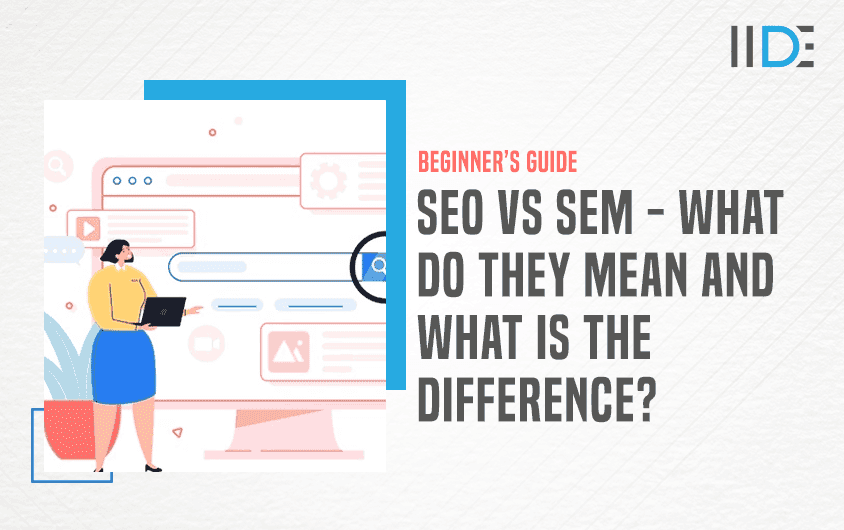What is SEO?
SEO (Search engine optimisation) is a digital marketing method used to increase the amount of web traffic, and improve the quality of web traffic to a particular website organically. The main aim of SEO is to rank on SERPs (search engine result pages). Organic web traffic is when your website gets unpaid traffic without any paid efforts and solely through SEO and other efforts.
There are 4 main types of SEO –
Off-page SEO includes SEO activities that do not happen on the page. It builds your site’s authority, credibility, and reputation by building links that connect your website to other good-quality websites.
On-page SEO involves the improvisation of each webpage to target a set of specified keywords that would best appeal to search engines and a user’s intent. Without SEO, even though your webpage might be well-designed, you may not get the visibility needed on a search engine.
Technical SEO includes certain elements of a website that are not related to content but more related to the backend and structure of the website. It makes it easier for search engine spiders or crawlers to crawl through your website, giving you a higher rank.
Content marketing SEO involves optimising everything related to content on your website. It focuses on the quality of content that helps your site to rank. Content that is rich in relevant keywords captures Google’s attention better. Hence, it is important to do thorough keyword research. Read more on how to do SEO keyword research here.
Also, if you’re looking to take your professional journey to the next level, consider enrolling yourself in digital marketing classes. It’s a skill set that can empower you to connect with audiences in innovative ways and achieve remarkable results.
Or, if you want to commit yourself to learning digital marketing in and out, then this MBA in digital marketing will be the perfect fit for you.
How Does SEO Work?
Now that you are familiar with the meaning of SEO, let’s have a look at how it works. Search engines such as Google use bots often referred to as spiders or web crawlers to crawl web pages and eventually place them in an index. When a user punches in a search, it is pulled out from this index. Think of it like a library where a user wants a particular book (in this case webpage).
There are several ranking factors that come into play for every search engine. These bots crawl through websites and indicate how well a particular website matches up to a user’s needs. It is purely based on user experience.
Relevant keywords, authoritative pages, and quality content are a few SEO goals that can essentially help your pages rank higher in search engines.
Learn with Experts: Online SEO Course
Examples of SEO
Some SEO strategy examples include –
Keyword optimization is crucial for SEO marketing as it is the keywords that help determine the success of your SEO marketing strategy. It decides where your webpage will appear on a search engine. For the most relevant leads, you need to optimize your website with the correct keywords.
Improvising on-page elements
Another example is optimizing on-page elements. These include the title, title tags, description, etc. that a user sees on a search engine. On-page elements impact the ranking of your website as they play a role in determining whether your page is relevant to the search or not.
Technical SEO involves improvising the backend of your website. This will enable web crawlers to effectively crawl your website which is critical in determining your site’s ranking. Ensure that your webpage does not take a lot of time to load.
Most users bounce if a site takes more than 3 seconds to load. Another example is ensuring that your website is mobile-responsive and user-friendly. More than 50% of internet users use smartphones, hence it needs to be designed in such a manner.
Create User-Friendly Pages
Always understand what a user’s search intent is. Accordingly, enhance your content. For example, if a user searches for ‘the best restaurants in Mumbai’, try and use this to your advantage by including the keywords on your website.
Another way of getting organic traffic to your website is SEO-rich content. This includes blogs, videos, infographics, Ebooks, and more. The content needs to incorporate focus keywords as well as related keywords. Try and incorporate the main keywords as many times as possible.
Link building – both internal and external is another example of SEO. Backlinks are links on other websites that link out to your website. It develops trust and credibility if the website is high-quality. This will drive traffic to your page. Internal links help the user stay on your site longer and easily navigate the internal pages of your website. These also help Google index your website.
The world of digital marketing is all about reaching customers online. If you’re interested in this dynamic field, there are numerous resources available. You can explore a variety of digital marketing blogs to gain valuable insights.
Or, if you are in location you can even consider enrolling in digital marketing courses in navi mumbai, digital marketing courses in south delhi or digital marketing courses in kolkata. By equipping yourself with these skills, you can unlock exciting opportunities in the ever-evolving digital landscape.
What is SEM?
You’re probably wondering what SEM is? Search Engine Marketing is a term that broadly describes any effort that helps your site get attention on a search engine, thereby increasing web traffic.
It involves many types of paid strategies such as PPC ads (pay-per-click ads), SMM (social media marketing and other types of paid ads).
As mentioned earlier, digital marketing is all about atrracting customers online. This broader field encompasses strategies like social media marketing, email marketing, and targeted advertising. Curious to learn more? Check out this digital marketing course with placement and get ahead in your digital career path.
How Does SEM Work?
Wondering how SEM works? On a search advertising platform, you bid for your advertisements to be displayed. Google Ads is a very popular platform with over 35% of digital marketers preferring it, followed by Facebook ads at 20%. Check this Google ads online course and Social Media Marketing course out to know more.
You conduct keyword research just like you would for SEO, post which you create ads that target the right target audience with your niche keywords for your product or service.
When users search for these keywords, your ads will be displayed in search engines. In PPC advertising, every time a user clicks on the ad, you would have to pay the bid amount.
Examples of SEM
Listed below are a few SEM strategy examples –
- Understand your Target Audience
It is imperative to understand your target audience’s search intent. It allows you to match your landing pages and content around the user’s needs and requirements.
Personalizing ads for desktop view and for mobile viewing is a very good SEM strategy example as it boosts the number of clicks on the ads.
Market your USP. This goes without saying – you need to highlight why a user needs to buy your product or service. What is so unique about it? How does it add value to a user’s life?
- Use organic and paid efforts
Using a combination of organic and paid efforts can really get you more recognition and brand awareness. This can lead to a higher click-through rate which will mean increased traffic resulting in higher conversions.
Create Email campaigns with a CTA that directs users to land on your website. Personalize your emails. By combining Email marketing with SEM, your results are bound to be better.
Track your ad campaign performance after every campaign. Understand which areas can be improved and how to apply learnings to your new strategy.
The key difference between SEO and SEM
Are SEO and SEM the same thing? As you can tell, SEO focuses 100% on organic results, SEM is an umbrella term that uses both paid and organic strategies. Let’s have a look at the key differences between SEO and SEM and what is SEO vs. SE –
1. SEO and SEM full form
Let’s get the basics right – SEO stands for search engine optimization and SEM stands for search engine marketing.
2. Using paid efforts
SEO does not use paid efforts – it is 100% organic. SEM, on the other hand, uses paid efforts and has ad designation. This is the main differentiation between the two. Note that SEM is an umbrella term and many marketers place SEO as a part of SEM.
3. Value or ROI
In the long run, SEO shows more returns on investment or value than SEM. SEM is more to do with instant results with limited traffic within a budget, whereas SEO is a long-term strategy that has unlimited traffic.
4. Payments
There is no payment required when a user clicks on your website for SEO. When it comes to SEM, every time a user clicks on your ad, you need to make a payment for that particular bid. Hence, SEM is more expensive than SEO.
5. Competition
Competition is lower for SEO than SEM. This is because competition is more for the targeted keywords that SEM has over SEO’s organic content.
6. Impact or Results
The time taken to show results for both vary. SEM is to do with instant results, whereas SEO takes time to show results but has long-term benefits.
7. Click-through-rates
The click-through rate for SEO is higher than that of SEM.
The world of marketing, especially digital marketing, is brimming with valuable insights and strategies. If you’re curious to learn more, then take a look at this free digital marketing masterclass which will equip you with the knowledge to understand how brands like McDonald’s reach their target audience and stay ahead of the curve.
Or, if you are not interested in learning about digital marketing but want to discover which other field might suit your interests, explore the free top paying skills course to find out more and pursue a career in the field you desire.







